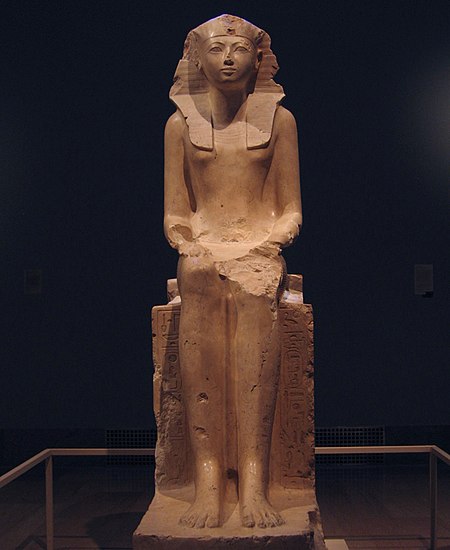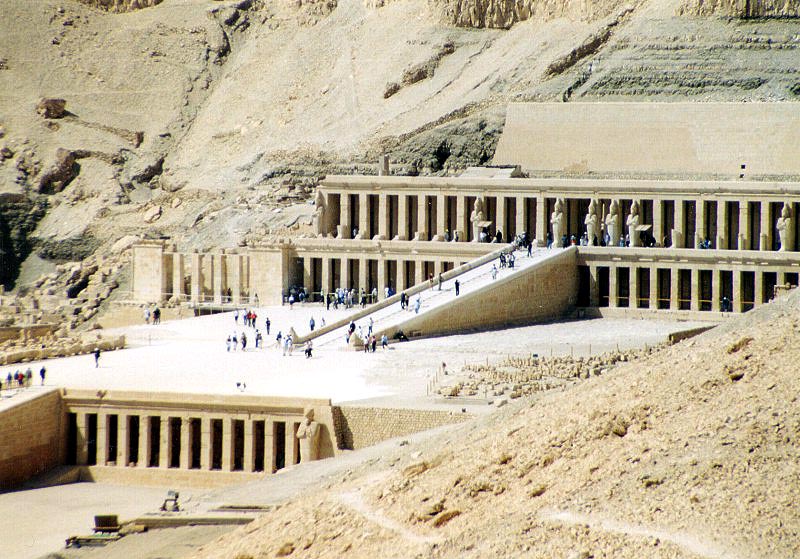 One of Egypt’s most famous pharaohs, Hatshepsut is known for an ambitious building program, legendary trading expeditions, and an exceptionally prosperous reign. Hatshepsut is most famous, however, for being one of the few women to rule Egypt as king. Until recently, the body of this legendary ruler was thought to be lost to history, destroyed, like her monuments, in attempts to wipe out all evidence of her reign. However, recent studies suggest that an anonymous mummy in the Valley of the Kings may indeed be "the king herself."
One of Egypt’s most famous pharaohs, Hatshepsut is known for an ambitious building program, legendary trading expeditions, and an exceptionally prosperous reign. Hatshepsut is most famous, however, for being one of the few women to rule Egypt as king. Until recently, the body of this legendary ruler was thought to be lost to history, destroyed, like her monuments, in attempts to wipe out all evidence of her reign. However, recent studies suggest that an anonymous mummy in the Valley of the Kings may indeed be "the king herself."
Hatshepsut lived during Egypt’s Eighteenth Dynasty, whose well-known members included Akhenaten, Nefertiti, and Tutankhamun. Her father was Thutmose I, and she married her half-brother, Thutmose II (a common custom for Egyptian monarchs). When Thutmose II died, his son Thutmose III, whom he fathered by another wife, was too young to rule. Queen Hatshepsut became his co-regent and ruled on his behalf, another common custom.
Hatshepsut broke with tradition, however, when she declared herself king. She ruled for a time on her own, and then later as co-Pharaoh with Thutmose III. She used male titles and portrayed herself with traditional kingly attributes. This probably helped to legitimize her reign, since Egyptian custom held that kings should be male. She also reinforced her right to rule by claiming divine descent, and emphasizing her royal lineage through her grandmother, Ahmose-Nefertari. Thutmose III eventually became king, but there is little evidence to suggest he felt animosity toward his step-mother. The destruction of her monuments most likely represents a later political attempt to erase the memory of a female pharaoh and preserve Egyptian tradition.

Hatshepsut’s official tomb, KV20, contained canopic jars for her internal organs but no mummy. A box inscribed for Hatshepsut was found in the cache of royal mummies at Deir el Bahri, but her mummy was not found there. The box contained viscera, probably r from the mummification process, and a fragment of a tooth. The tomb of Hatshepsut’s wet nurse, Sitre-In, is labeled KV60 and contained two female mummies. One was found in a coffin inscribed for Sitre-In, the other was on the floor without a coffin. Despite the fact that her left arm was crossed over her chest in the gesture associated with royalty, the latter mummy was ignored while Sitre-In was taken to a museum. After all, there was little to suggest the glory of who this mummy had been in life- the body was of an obese woman around 50 years old, who suffered from severe gum disease and tooth decay, diabetes and advanced bone cancer.
In 1989, fragments from a gilt wooden coffin were found in KV60. This coffin had a notch for the attachment of a false beard of the type worn by pharaohs, which might suggest a pharaoh had once been buried there- but the bodies from the tomb were both women. Recent analysis of the mummy left in the tomb also showed that it was missing a tooth. When researchers compared it to the tooth fragment from the box inscribed for Hatshepsut, it proved to be an exact match. It was becoming evident that this mummy could be that of the legendary queen. The next step in the process is DNA analysis, which is currently being conducted. Preliminary tests have been “encouraging” in suggesting a relationship between this mummy and that of Ahmose-Nefertari, Hatshepsut’s grandmother.
The search for Hatshepsut’s mummy has led to the construction of a new DNA laboratory near the Cairo Museum, the first of its kind dedicated specifically to mummy studies. National Geographic Magazine also made Hatshepsut the cover story for its April issue. With all of this excitement and new possibilities for research, the results of this study will be widely anticipated and may solve one of ancient Egypt’s greatest mysteries.

Image Credits:
1. Wikimedia Commons: Hatshepsut, Eighteenth dynasty of Egypt, c. 1473-1458 B.C. Indurated limestone sculpture at the Metropolitan Museum of Art,New York City. Photo by Postdlf
2. Wikimedia Commons: Schreibkraft and Luestling